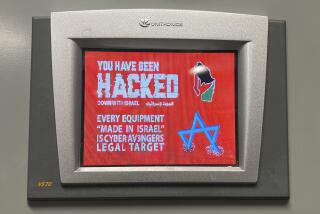Utilities Move to Remote-Controlled Metering : Technology: In the ‘90s, your gas and water usage may be gauged via telephone, power and cable TV lines.
- Share via
Donald Springmeyer is reading water meters in his sleep.
Overnight, a computer at the Candlewood Shores, Conn., water department uses telephone lines to collect meter information remotely.
The department, of which Springmeyer is general manager, is among the first to employ a new generation of technology.
Utilities of the 1990s will be using telephone lines, power lines, cable television lines and even the airwaves to find out silently how much gas, electricity and water their customers are using.
Utilities in the United States and worldwide are testing and installing so-called automated meter reading systems, which can transmit data by radio or wire.
Over the next decade, they will replace human meter readers and do away with the estimated bill. The systems also will be powerful tools with which utilities will remotely control equipment, detect failures and leaks and promote and operate a broad range of programs to conserve energy and water resources.
It is estimated that no more than 60 utilities nationwide have installed such systems, but that dozens more are experimenting with them.
Systems are being tested by several Connecticut power, water and gas utilities, including Northeast Utilities, the Metropolitan District in Hartford and, in a combined project to begin in January, by the Bridgeport Hydraulic Co., the Southern Connecticut Gas Co. and United Illuminating of New Haven.
Northeast Utilities last July began installing telephone-operated systems in 200 locations in New Britain, including the headquarters of the state Department of Public Utility Control.
On Nov. 1, the Metropolitan District began testing similar devices in 100 homes and small businesses in East Hartford. The district hopes to begin permanent installations in 1991.
In July, the tiny Candlewood Shores Tax District Water Department became the state’s first utility to install a permanent system for all customers, 465 homes around Candlewood Lake in Brookfield. From midnight to 7:15 a.m., the department’s computer can read all the meters.
When the system was installed, the water department discovered that several homes were using up to 2,000 gallons of water daily, nearly seven times the average. Following notification, the homes’ daily water use dropped to about 350 gallons.
“I’m so thrilled with this thing that it’s unbelievable,” Springmeyer said.
By monitoring consumption, Springmeyer also can detect problems with any one of his seven wells, and his system notifies him when a customer’s water use continues uninterrupted, indicating a potential leak. And the system can tell Springmeyer if anyone is tampering with the meter or if the five-year battery is running low.
Candlewood Shores, which had been charging its customers a flat fee because it had no meters, was ordered to install them by state utility regulators concerned about uncontrolled consumption. By installing the $125,000 automated system, Springmeyer has not had to add any meter readers to his three-employee staff.
The Candlewood system was examined in September by New York City water officials, who have 630,000 unmetered customers.
By the end of the next decade, it is estimated that up to 90% of utilities nationwide will use automated meter reading in some portion of their systems.
“The technology is really catching on. It’s fascinating,” said Steven F. Ostrega, president of the 2-year-old Automated Meter Reading Assn. and deputy commissioner-director of the New York City Bureau of Water Register.
Last summer, the bureau began installing six different automated systems in 625 premises in the five boroughs. Along with Consolidated Edison, the experiment includes Brooklyn Union Gas, which, in a separate project, is permanently installing radio-based systems in 80,000 homes and businesses.
Utilities are operating or testing systems in Des Moines, Iowa, Boston, Philadelphia, Minneapolis and elsewhere.
Automated meters also are being tested in Japan, Britain and Italy.
The systems let utilities conduct two-way electronic conversations with their meters and other remote equipment much in the same way that data is transferred from one computer to another.
In the most popular system, a utility computer dials out on telephone company test lines, which then wake up the electronic metering equipment without ringing the customer’s telephone. Data can be received and sent in three seconds.
Most transmission is done overnight, when telephone rates are lowest and telephones are not being used. But even so, a customer retains control of his phone. Picking up the receiver during data transmission, for example, simply cuts off the utility. The systems cannot overhear telephone conversations, a point that utilities stress when reassuring customers concerned that their privacy may be invaded.
In another type of system, the meters can be programmed to call the utility at a certain time. Still others send encoded data over power and cable television lines or over the airwaves.
The utilities pay for installing the equipment, which, at the user’s end, amounts to a textbook-sized box and possibly a new meter.
More to Read
Inside the business of entertainment
The Wide Shot brings you news, analysis and insights on everything from streaming wars to production — and what it all means for the future.
You may occasionally receive promotional content from the Los Angeles Times.









